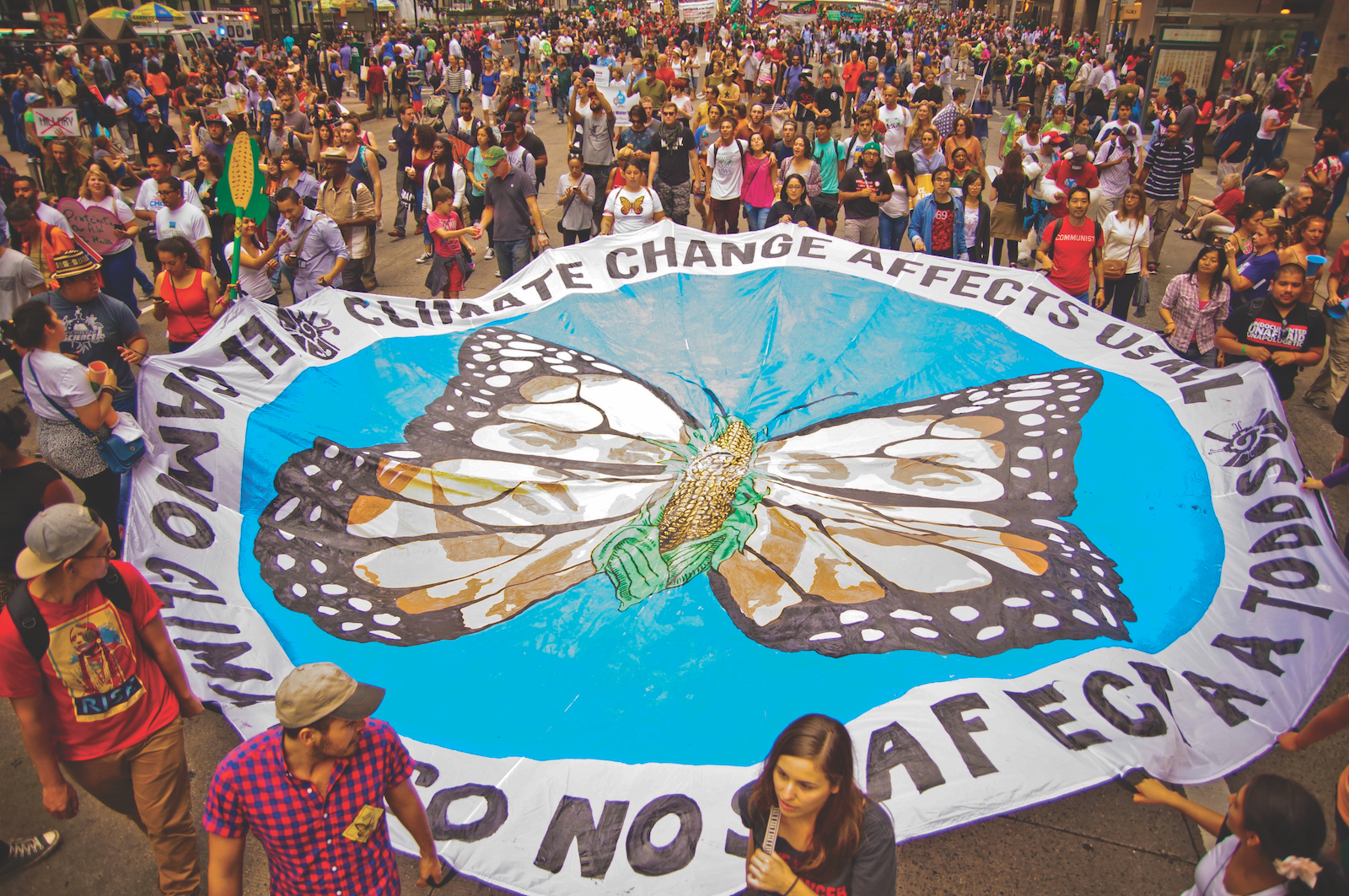The World We Need celebrates America’s unsung grassroots environmental groups — often led by people of color and the poor — that defend communities against polluting industries and help them mitigate the impacts of climate change. This excerpt highlights the work of artist activists from CultureStrike, now called the Center for Cultural Power, and Justseeds Artists’ Cooperative.
This post was produced in partnership with The New Press.
Micah Bazant was floored by a video of Kandi Mossett. Mossett, an organizer with the Indigenous Environmental Network, was describing how her Mandan, Hidatsa, and Arikara people, displaced from their original homes, ended up in a place considered a wasteland — New Town, now on the Fort Berthold Indian Reservation in North Dakota. Then industry discovered valuable resources. And since the mid-2000s, a fracking boom has swept North Dakota.
The expansiveness of the oil extraction facilities, “with flares that are so big that you can see them from space,” is conveyed in Bazant’s contribution to “We Are the Storm,” a portfolio of prints produced in 2015 by CultureStrike, a migrant-led organization that mobilizes culture for social justice, and the Justseeds Artists’ Cooperative. Through conversations with Mossett, Bazant, a white trans visual artist, chose to “honor the struggle of women in the environmental justice movement.” The print depicts three women “looking at this wound in the body of the earth,” said Bazant, and makes “visual connections between these violent colonial systems, and systems of extraction from the earth and our bodies.”
“We Are the Storm” spotlights the resistance groups and communities on the front lines of climate change. Two of the three curators, Roger Peet and Favianna Rodriguez, had previously worked together to produce the “Migration Now!” art portfolio to highlight migrant struggles, and artists affiliated with CultureStrike and Justseeds had created some of the iconic images and installations associated with the first People’s Climate March in 2014. (Gabriel Harrison is the third curator). Now, armed with an idea to highlight the grassroots environmental movements organizing against climate change, the curators tapped the nationwide network of CultureStrike and Justseeds artists again.
The 22 prints of “We Are the Storm” cover a range of movements: a Latinx immigrant organization seeking to build healthier communities in San Francisco (PODER), an Indigenous encampment fighting tar-sands pipelines in northern British Columbia (Unist’ot’en), a group targeting fossil fuel corporations headquartered in St. Louis (Missourians Organizing for Reform and Empowerment), and an Arizona organization helping migrants — some are climate migrants — who are crossing the border (No More Deaths).
“The portfolio is trying to bring a pretty specific political message: There is a broad variety of ways in which people are engaging with how climate change is transforming our world and society,” said Peet. “You can pitch to a gallery or public space, and they function as a readymade tool for public communication.”
Selections from ‘We Are the Storm’
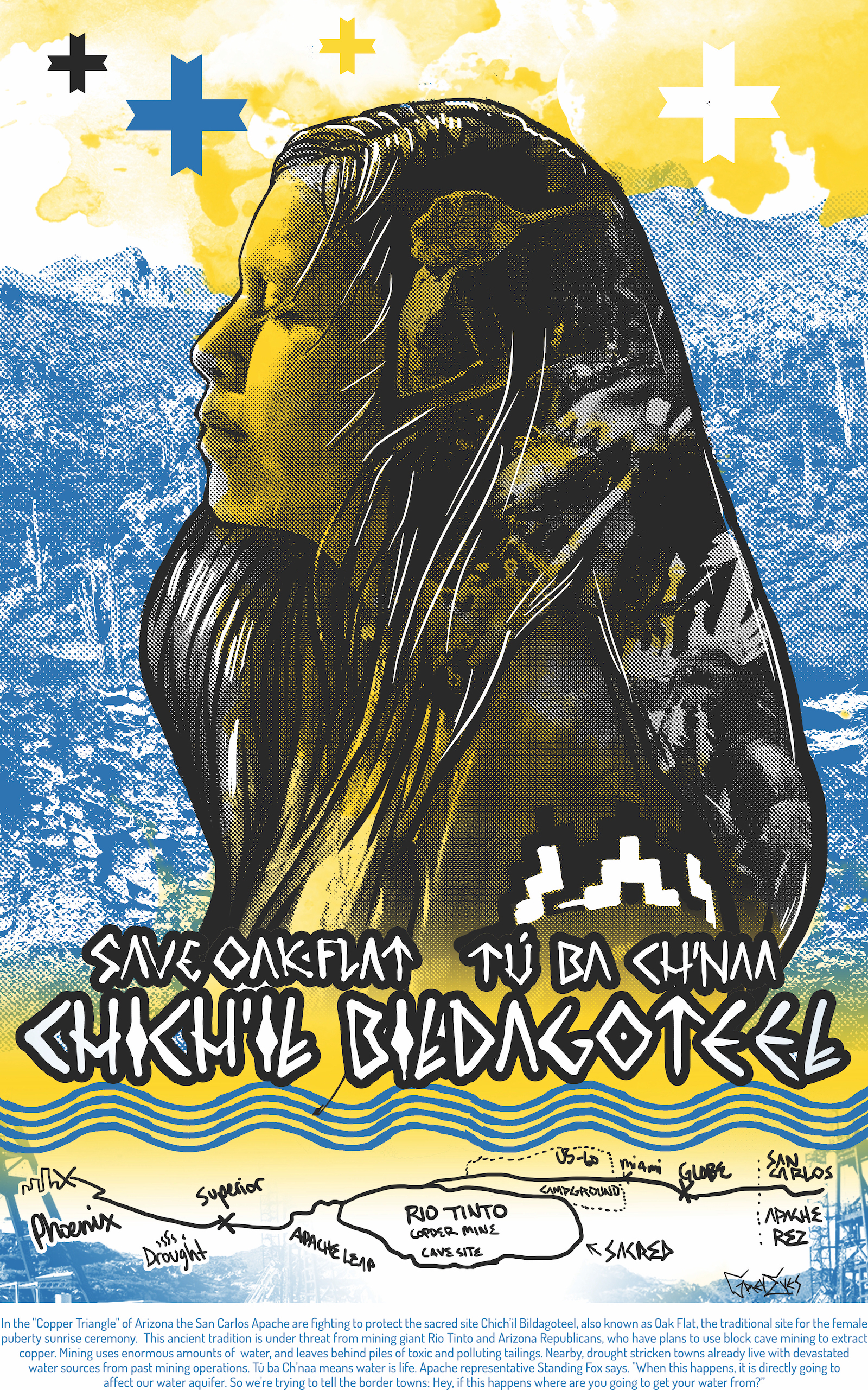
The San Carlos Apache, situated in Arizona’s Copper Triangle, are fighting to protect the sacred site Chich’il Bildagoteel, also known as Oak Flat. It is the traditional location for a female puberty sunrise ceremony. This ancient tradition is under threat from mining giant Rio Tinto and Arizona Republicans, who have plans to use block cave mining to extract copper.
Thomas GreyEyes is an interdisciplinary artist from the Navajo Nation who was raised throughout Arizona. He uses site-specific graffiti installations, print, performance, and video art to convey antiauthoritarian messages to the dominant society.
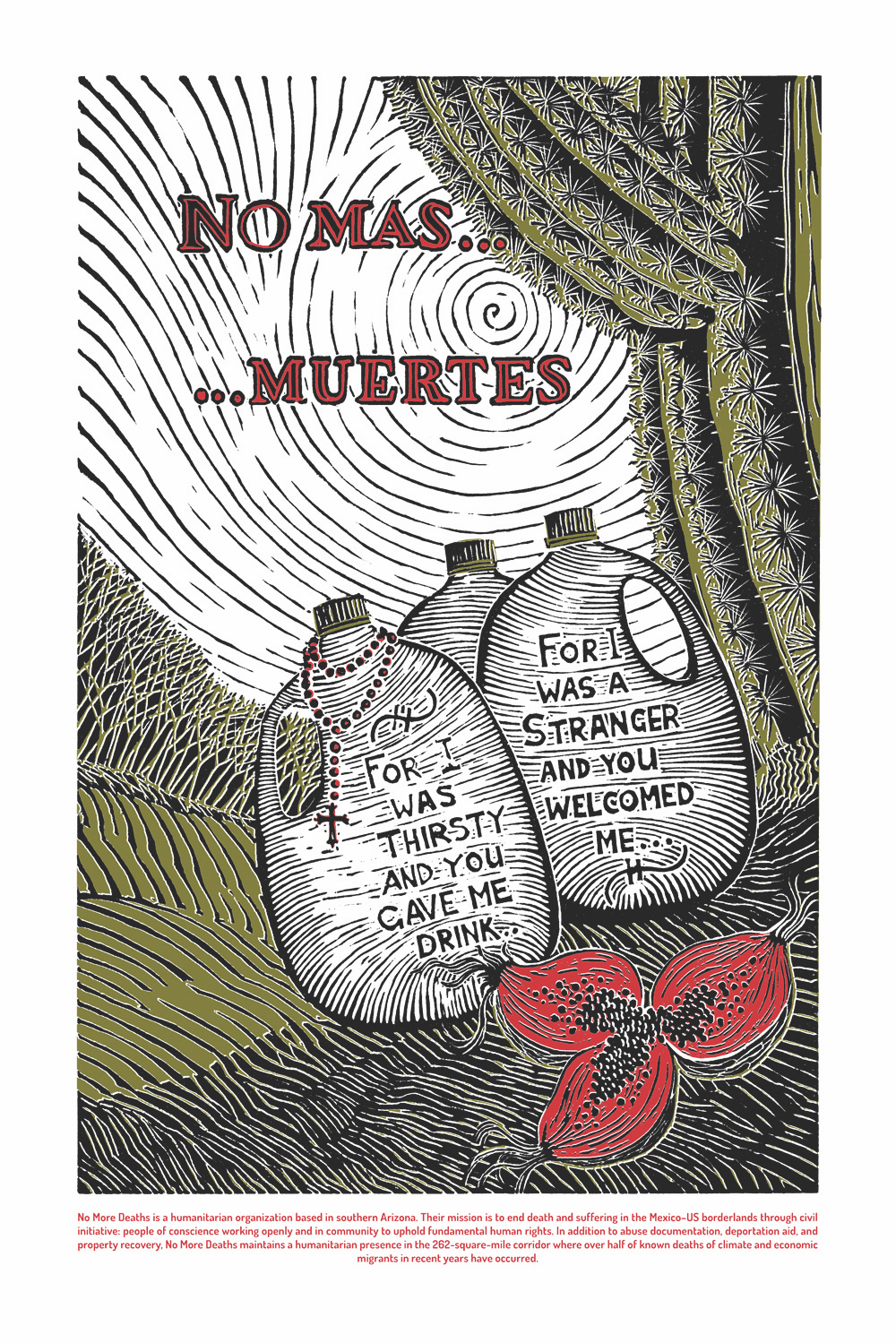
No More Deaths is a humanitarian organization in southern Arizona. Its mission is to end death and suffering along the border through civil initiative: people of conscience working openly and in community to uphold fundamental human rights.
Fernando Martí, originally from Guayaquil, Ecuador, grew up crossing borders. Now a San Francisco–based printmaker, architect, and writer, he brings his training in architecture and urbanism, as well as his engagement with urban politics, to his prints, constructions, and public projects.
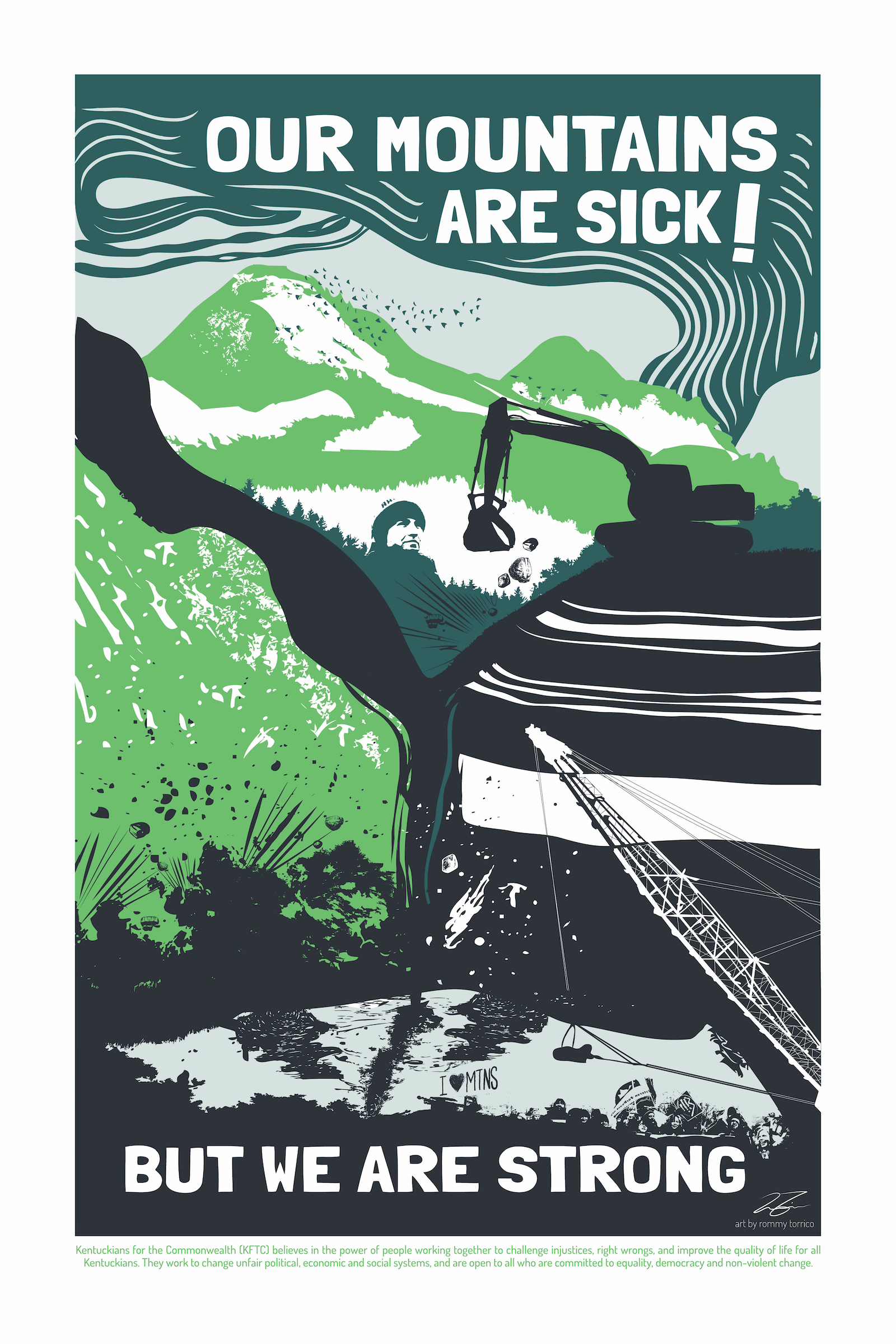
Kentuckians for the Commonwealth believe in the power of people working together to challenge injustice and improve the quality of life for all Kentuckians. They work to change unfair political, economic, and social systems, and are open to all who are committed to equality, democracy, and nonviolent change.
Rommy Torrico is a queer, undocumented, trans art activist who was born in Iquique, Chile, and now lives in Naples, Florida. They have long been involved in the immigrant rights struggle, and their work is infused with their personal experiences and the stories of their community.

Radical Action for Mountain People’s Survival (RAMPS) is a nonviolent direct action campaign in the southern coalfields of West Virginia dedicated to ending all forms of strip mining in Appalachia. RAMPS’ direct action tactics are part of the larger movement to end mountaintop removal.
Bec Young is a visual artist who works primarily in printmaking, paper cutting, illustration, and installation. Her practice includes direct interactions within communities, empowering others, skill sharing, and facilitating change. Her work has been shown internationally, including in the United States, Canada, Mexico, Germany, Slovenia, and Great Britain, and was included in “A Survey of Contemporary Printmaking.”
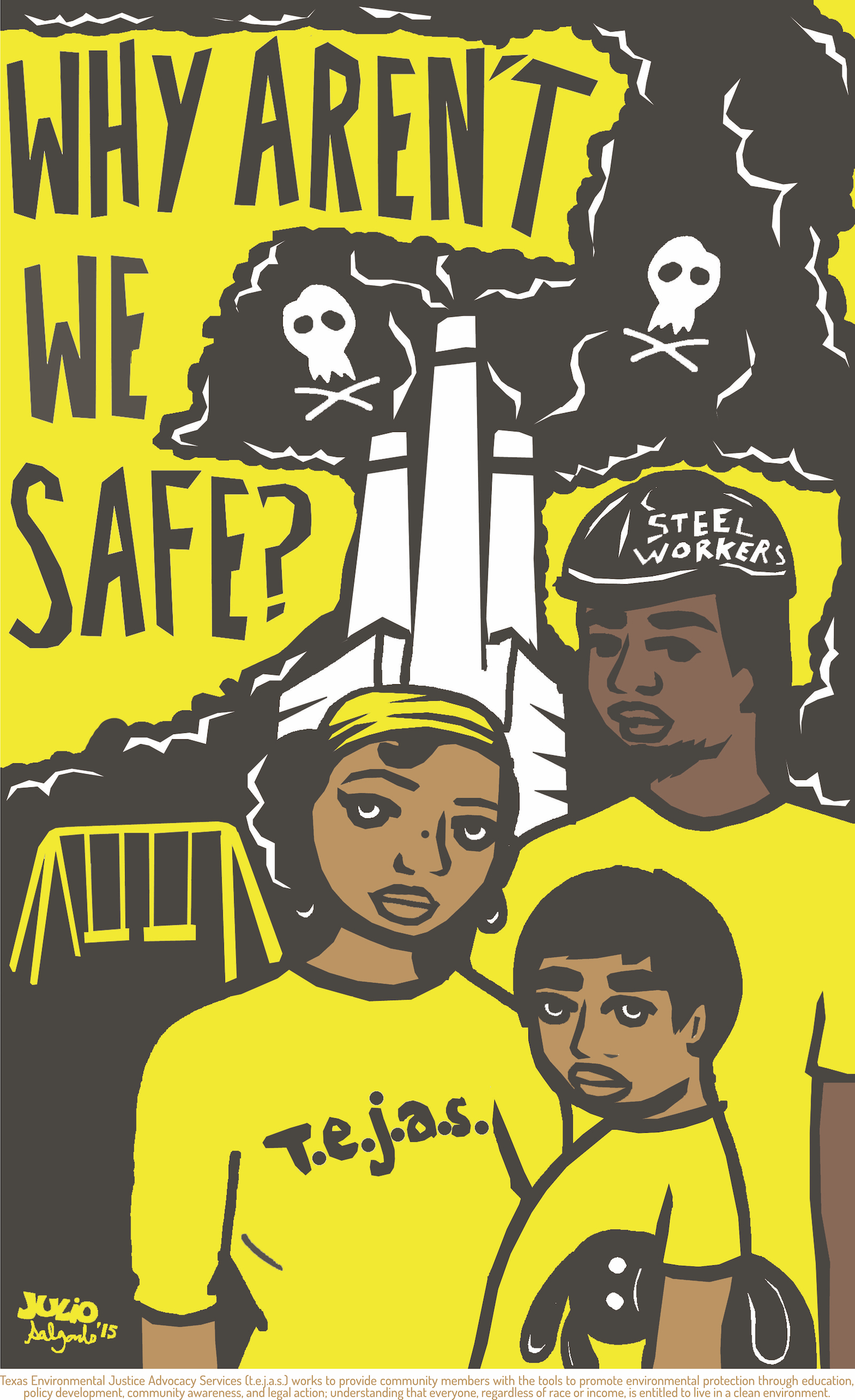
Texas Environmental Justice Advocacy Services (T.E.J.A.S.) works to provide community members with the tools to promote environmental protection through education, policy development, community awareness, and legal action, with the understanding that everyone, regardless of race or income, is entitled to live in a clean environment.
Julio Salgado is the cofounder of DreamersAdrift.com, and events and project coordinator at CultureStrike. His status as an undocumented queer art activist has fueled the contents of his illustrations, which depict key individuals and moments of the DREAM Act movement. Undocumented students and allies across the country have used Salgado’s artwork to call attention to the youth-led movement.

The Indigenous Environmental Network, established in 1990 and based in Bemidji, Minnesota, works to build the capacity of Indigenous communities and tribal governments to protect sacred sites, land, water, and air while improving the health of people and of all living things and building economically sustainable communities.
Micah Bazant is a visual artist and graphic designer. He works with social justice movements, creating art inspired by struggles to decolonize ourselves from white supremacy, patriarchy, and the gender binary, and to reimagine ourselves in right relation to the planet in the face of catastrophic climate change.
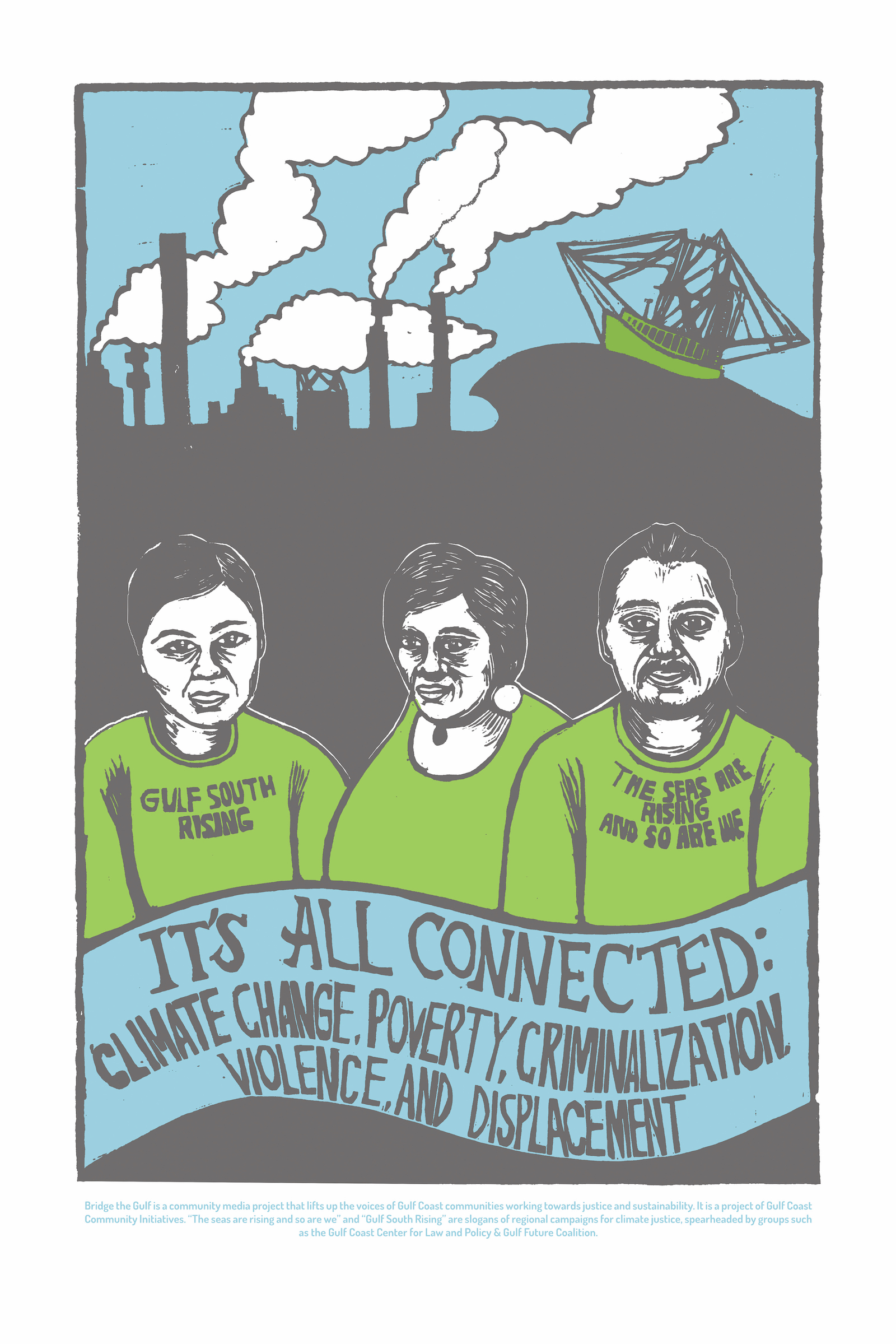
Bridge the Gulf is a community media project that lifts up the voices of Gulf Coast communities working toward justice and sustainability.
Meredith Stern’s practice includes printmaking, ’zine publishing, and socially engaged creative production. Meredith is a member of the Justseeds Artists’ Cooperative and has collaborated on several large-scale art installations at the national and international levels. Her work is part of the permanent collection of Book Arts at the MOMA, the Library of Congress, and in universities and libraries around North America.
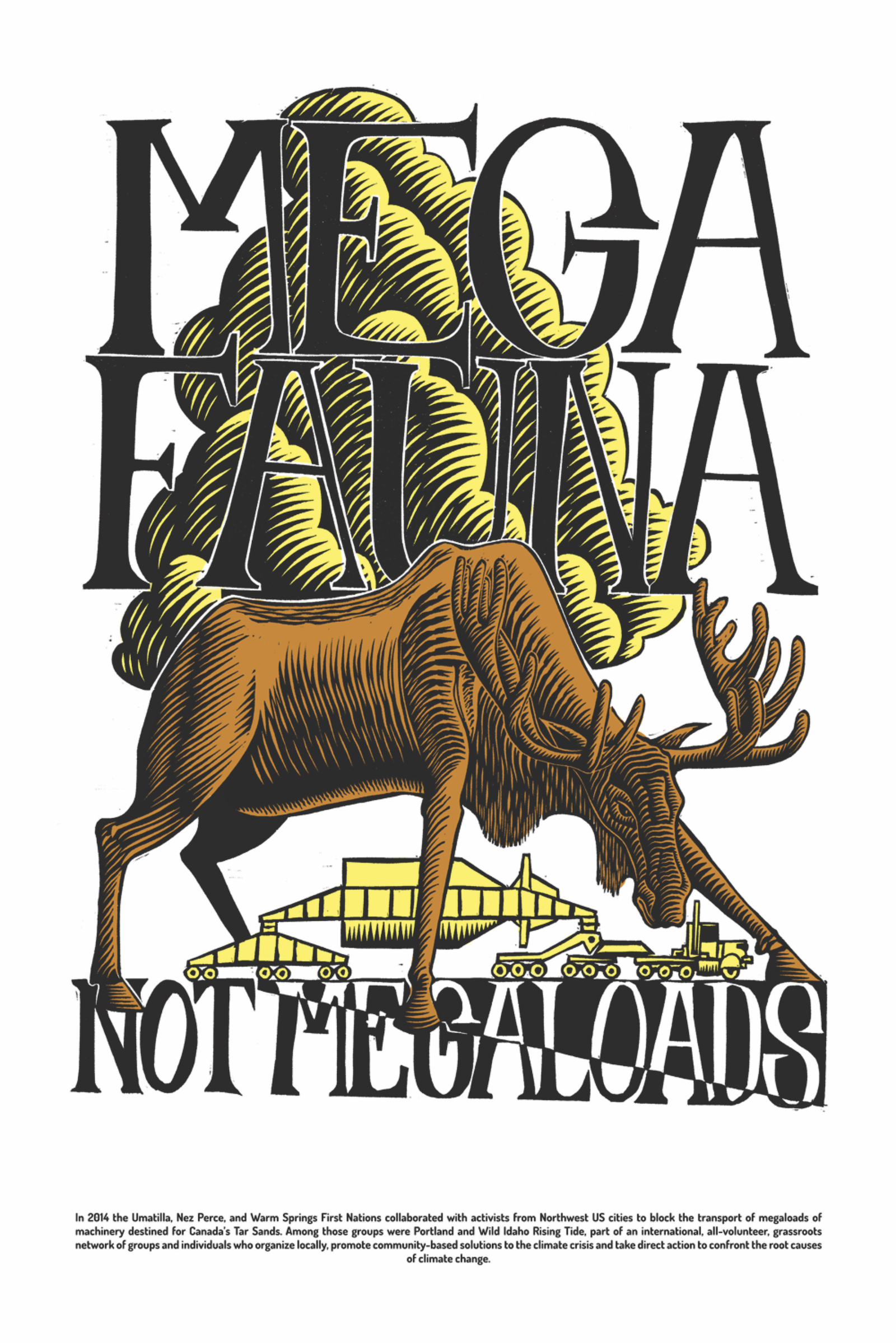
Portland and Wild Idaho Rising Tide are social activist organizations that are part of an international, all-volunteer, grassroots network of groups and individuals who organize locally, promote community-based solutions to the climate crisis, and take direct action to confront the root causes of climate change.
Roger Peet is an artist and printmaker in Portland, Oregon. His work often focuses on issues of ecology and violence, and on relations between the human and nonhuman realms. He collaborates with artists, activists, and scientists around the globe in the service of a more generous and wilder world.
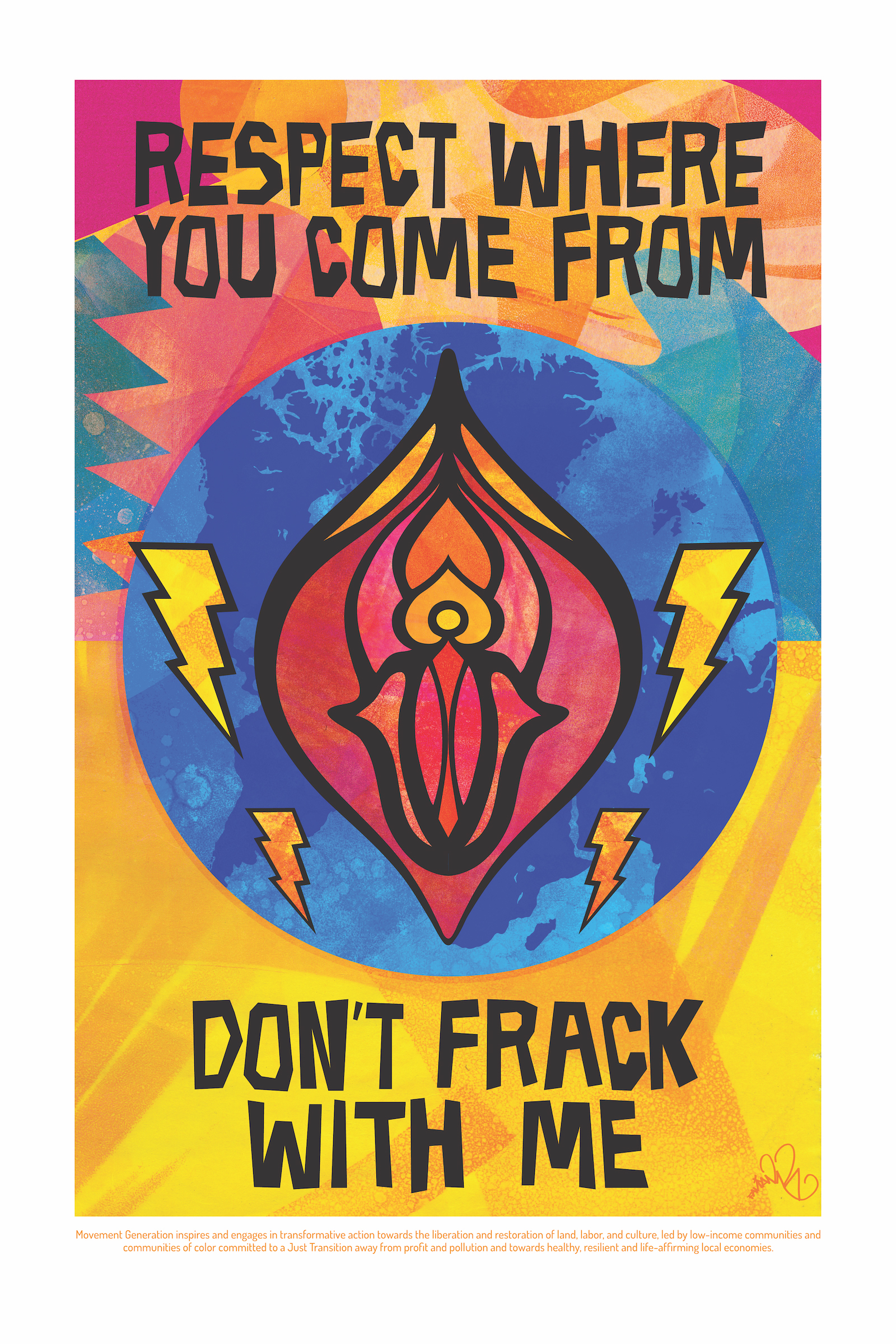
Movement Generation inspires and engages in transformative action toward the liberation and restoration of land, labor, and culture. Led by low-income communities and communities of color committed to a just transition, they seek to build healthy, resilient, and life-affirming local economies.
Favianna Rodriguez is an interdisciplinary artist, cultural organizer, and political activist. Her art and collaborative projects address migration, economic inequality, gender justice, and ecology. Favianna lectures globally on the power of art, cultural organizing, and technology to inspire social change, and leads art interventions in communities around the country.
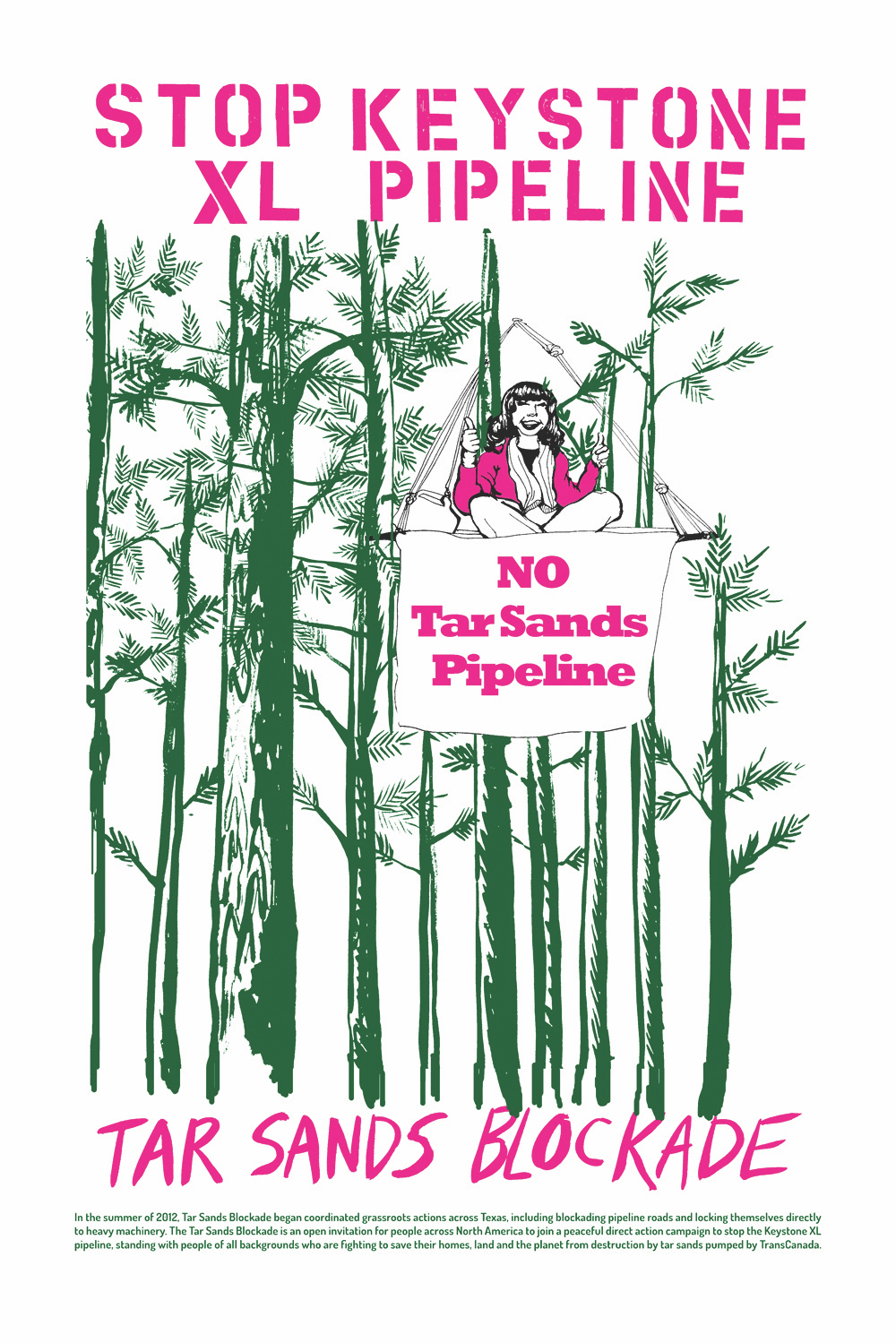
In the summer of 2012, members of Tar Sands Blockade engaged in coordinated grassroots actions across Texas, blockading pipeline roads and locking themselves to heavy machinery. Their work is an open invitation for people across North America to join a peaceful, direct-action campaign to stop the Keystone XL pipeline.
Mary Tremonte is a founding member of Justseeds Artists’ Cooperative and works with “printmaking in the expanded field,” including “printstallation,” and interactive silkscreen printing in public spaces. Mary has exhibited, presented lectures and workshops, and performed internationally.
Copyright © 2021 by The New Press. This excerpt originally appeared in The World We Need edited by Audrea Lim and reprinted here with permission.
Correction: We originally misidentified Micah Bazant and Roger Peet as cofounders of Justseeds Artists’ Cooperative, which they are not.
Fix, Grist’s solutions lab, is hosting The World We Need: An Exploration of Art and Justice on May 27. This virtual event will investigate the relationship between art and environmental justice through the work of artists and Grist 50 honorees Favianna Rodriguez and Beka Economopoulos. Register here.

